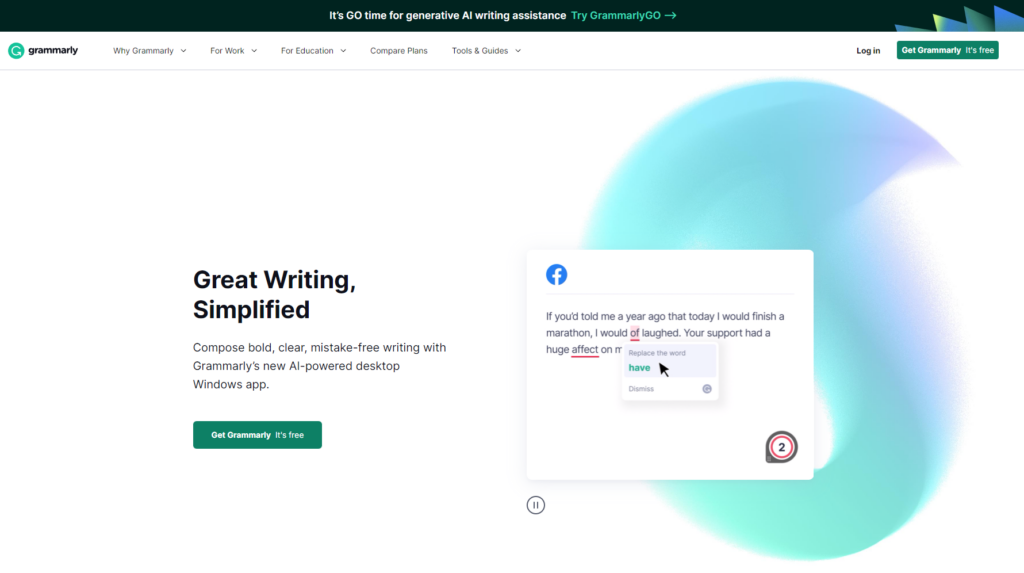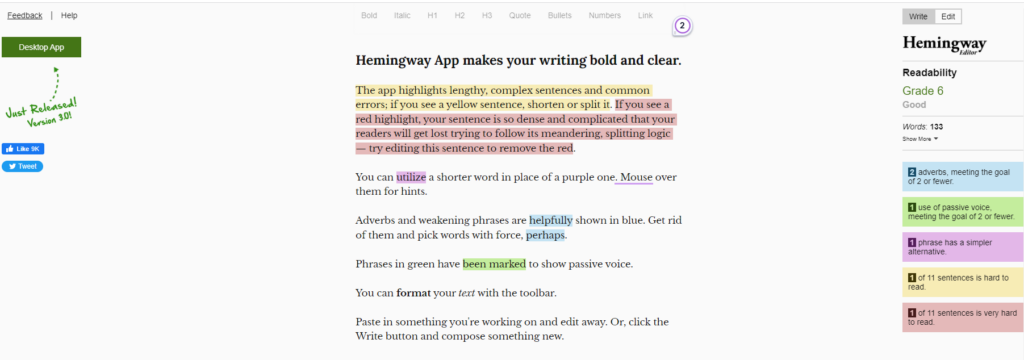Hemingway Editor and Grammarly are the most popular writing and grammar tools today. They have gained widespread popularity due to their ability to help users improve their writing, making it more concise, clear, and error-free. This article will compare and contrast Hemingway Editor and Grammarly, exploring their strengths and weaknesses, the path to success, and the current situation.
Background Information
Grammarly was founded in 2009 by Alex Shevchenko and Max Lytvyn, two Ukrainian entrepreneurs who wanted to create a tool to help people write more effectively. The device uses artificial intelligence and natural language processing to check for spelling and grammar errors, suggest better word choices, and provide writing style feedback. Grammarly has over 10 million users worldwide and is available as a browser extension, desktop, and mobile app.

Grammarly is a writing and grammar tool that has become one of the most popular writing tools in the world. The device uses artificial intelligence and natural language processing to check for spelling and grammar errors, suggest better word choices, and provide writing style feedback.
Detailed History of Grammarly

2008-2009: Founding and Early Years
The initial version of Grammarly was a simple browser extension that checked for basic spelling and grammar errors.
In 2009, Grammarly raised $1 million in seed funding from a group of angel investors, allowing the company to expand its team and develop new features.
2010-2012: Growth and Expansion
In 2010, Grammarly launched a premium version of its tool, offering more advanced features like a plagiarism checker, style suggestions, and vocabulary enhancement. The company also launched a desktop app and a Microsoft Word plugin, making it easier for users to access the tool.
In 2012, Grammarly raised $10 million in funding from General Catalyst Partners, expanding its team and developing new features. The company also launched a mobile app for iOS and Android, allowing users to check their writing on the go.
2013-2016: Partnerships and Integrations
In 2013, Grammarly announced a partnership with Coursera, an online learning platform, to offer writing feedback and suggestions to students taking online courses. The company also partnered with Microsoft, integrating its tool into Microsoft Office products like Word and Outlook.
In 2016, Grammarly launched an enterprise version of its tool, allowing businesses to integrate Grammarly into their workflow and provide writing feedback to employees. The company also partnered with the National Hockey League, offering writing feedback and suggestions to players and coaches.
2017-Present: Continued Growth and Expansion
In 2017, Grammarly raised $110 million in funding from General Catalyst and IVP, allowing the company to expand its team and develop new features. The company also launched a native app for macOS, making it easier for Mac users to access the tool.
In 2018, Grammarly announced that it had surpassed 10 million registered users, making it one of the most popular writing tools in the world. The company also launched a new feature called “tone detection,” which analyzes the tone of a piece of writing and provides feedback on how readers might perceive it.
In 2020, Grammarly launched a new feature called “Grammarly for Education,” providing writing feedback and suggestions to K-12 schools and universities. The company also expanded its language support, adding new languages like Spanish, French, and German.
Today, Grammarly has over 30 million registered users and is available as a browser extension, desktop app, and mobile app. The company continues to grow and develop new features, helping people worldwide improve their writing.
On the other hand, Hemingway Editor was created by Adam and Ben Long, a father and son team from Florida. The tool is named after the famous writer Ernest Hemingway, known for his simple and direct writing style. The Hemingway Editor aims to help writers make their writing more precise and concise by highlighting complex sentences, passive voice, and adverbs. The tool is a web-based and desktop app and has gained a following among writers and editors.
Hemingway Editor is a writing tool named after the famous writer Ernest Hemingway, known for his simple and direct writing style. The tool aims to help writers make their writing more straightforward and concise by highlighting complex sentences, passive voice, and adverbs.
Detailed History of Hemingway Editor

2013: Founding
Hemingway Editor was founded in 2013 by Adam and Ben Long, a father and son team from Florida. The tool was inspired by Hemingway’s writing style and the idea that good writing should be clear and concise.
The initial version of Hemingway Editor was a web-based app highlighting complex sentences and suggesting ways to simplify them. The app also provided a readability score based on the reading level required to understand the writing.
2014-2016: Growth and Expansion
In 2014, Hemingway Editor launched a desktop version of its tool, allowing users to download and use the app offline. The desktop version added new features like the ability to save and export documents and a “write” mode that allowed users to focus on their writing without distractions.
In 2015, Hemingway Editor added a new feature called “Highlights,” which highlighted passive voice, adverbs, and other issues that might affect the clarity of writing. The tool also added a new “Grade” feature that provided a grade level for the paper based on the Flesch-Kincaid readability test.
In 2016, Hemingway Editor launched a new version of its web-based app, adding the ability to format text and select different writing modes like “write” or “edit.” The tool also added a new feature called “Goals,” which allowed users to set writing goals and track their progress.
2017-Present: Continued Development
In 2017, Hemingway Editor launched a new feature called “Hemingway Highlights,” which added new suggestions and insights into writing, including advice on sentence structure, word choice, and readability. The tool also added a new “Readability” feature that provided a score for how easy or difficult the writing was to read.
In 2019, Hemingway Editor was acquired by Automattic, the company behind WordPress.com. The acquisition allowed Hemingway Editor to continue its development and expand its reach.
Today, Hemingway Editor is available as a web-based and desktop app for both Windows and Mac. The tool has gained a following among writers and editors looking for a simple and effective way to improve their writing. The company continues to develop new features and refine its existing ones to make it easier for writers to create clear, concise, and compelling writing.
Path to Success
Hemingway Editor and Grammarly have experienced significant growth and success over the years. Grammarly’s success can be attributed to its marketing efforts, which include influencer partnerships, social media marketing, and content marketing. The company has also raised over $200 million in funding, allowing it to expand its team and develop new features.
On the other hand, Hemingway Editor has relied on word of mouth and positive reviews to gain popularity. The tool’s simple and intuitive interface has made it appealing to writers and editors looking for a device that is easy to use and provides actionable feedback.
Pros and Cons
While both Hemingway Editor and Grammarly aim to help users improve their writing, they have different approaches and features. Here are some of the pros and cons of each tool:
Grammarly
Pros
- Provides real-time feedback and suggestions
- Checks for grammar, spelling, punctuation, and style errors
- Offers a plagiarism checker
- Can be overly prescriptive in its writing suggestions
Cons
- Can be expensive for premium features
- Sometimes suggests unnecessary or awkward changes
- Can be overly prescriptive in its writing suggestions
Hemingway Editor
Pros
- Highlights complex sentences, passive voice, and adverbs
- Offers readability scores and suggestions for improvement
- Encourages concise writing
- Affordable one-time purchase
Cons
- Does not check for spelling errors
- Can be too simplistic in its feedback
- Does not offer suggestions for alternative words or phrasing
Current Situation
Both Hemingway Editor and Grammarly continue to grow and develop new features. Grammarly has recently launched a new feature called Tone Detector, which analyzes the tone of a piece of writing and provides feedback on how readers might perceive it. The company has also expanded its language support, adding new languages like Spanish, French, and German.
Hemingway Editor, meanwhile, has recently updated its web-based app, adding new features like dark mode and the ability to save and export documents. The tool continues to be popular among writers and editors looking for a simple and effective way to improve their writing.
Both Hemingway Editor and Grammarly are potent tools that can help users improve their writing. While Grammarly is more comprehensive in its approach, offering real-time feedback and suggestions for grammar, spelling, punctuation, and style errors, Hemingway Editor provides a more focused approach, helping writers improve the clarity and concision of their papers.